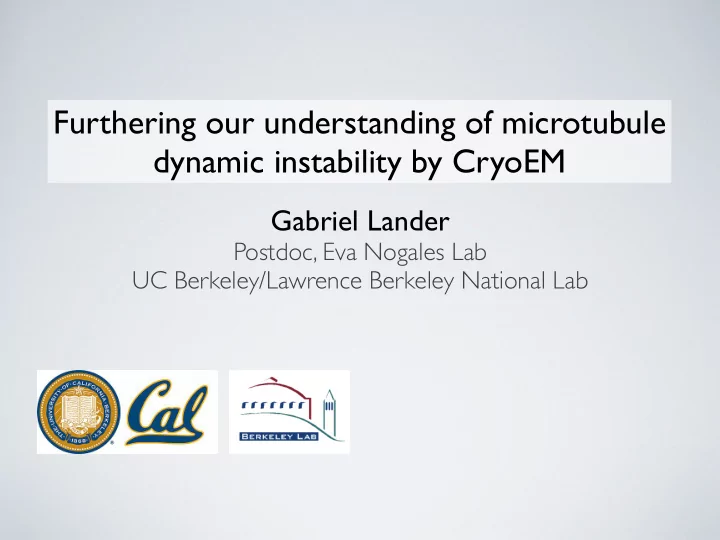

Furthering our understanding of microtubule dynamic instability by CryoEM Gabriel Lander Postdoc, Eva Nogales Lab UC Berkeley/Lawrence Berkeley National Lab
Greg Alushin
The Microtubule • Microtubules are among most important components of the cytoskeleton • Fundamental part of many physiological processes: • intracellular transport • cell motility • cell polarization • cell division
The Tubulin Dimer - The Microtubule Building Block Beta Subunit Alpha Subunit
Tubulin dimers assemble longitudinally Protofilament
Microtubule
Microtubule Seam Breaks Helical Symmetry Microtubules are not static structures - their ability to assemble & depolymerize is essential to cellular function.
The Nucleotide Binding Pocket GTP Exchangeable site Beta Subunit (E-site) (GDP) Free tubulin can exchange GDP for GTP Non-exchangeable site (N-site) Alpha Subunit (GTP)
The Nucleotide Binding Pocket GTP is required at Beta Subunit beta subunit for MT (GTP) polymerization, creating strong inter- tubulin contacts Alpha Subunit (GTP)
The Nucleotide Binding Pocket Beta Subunit GTP hydrolysis to (GDP) GDP weakens the inter-tubulin contacts Alpha Subunit (GTP)
Microtubule Dynamic Instability GTP “Cap” {
Microtubule Dynamic Instability
Microtubule Dynamic Instability Mechanism relating GTP hydrolysis to dynamic instability still unknown
Atomic-Resolution Structures X-ray Electron Crystallography Crystallography X-ray X-ray (1FFX,1SA0,1Z2B, (1TUB,1JFF,1TVK) Crystallography Crystallography 3DU7,3HKB,3N2G,3RYC, Zinc-induced antiparallel (4DRX,4F6R) (4FFB) 4F61,4UT5) tubulin sheets + DARPin-bound dimer TOG-bound dimer Polymers bound to stabilizing ligand stathmin-like domains
CryoEM of Microtubules
Subnanometer-Resolution CryoEM Structures Kikkawa and Hirokawa Sindelar and Downing Li et al . Structure 2002 (9Å resolution) EMBO J 2006 (9.5Å resolution) PNAS 2010 (8.5Å resolution) Are microtubules only ordered to 8Å resolution? Fourniol et al. JCB 2010 Alushin et al . Nature 2010 Maurer et al . Cell 2012 Yajima et al . JCB 2012 (8Å resolution) (8.6Å resolution) (8Å resolution) (9Å resolution)
FEI Titan EM (aka “The Beast”) • C3 active, parallel illumination • 300keV • 2K CCD, no DD = film collection • No Leginon = Tecnai Low Dose • Side-entry holder • “Weird State” feature!
Microtubule Distortions Bending Flattening
Distinguishing Alpha from Beta In an EM micrograph, alpha tubulin is indistinguishable from beta tubulin
Human Kinesin Monomer Rice et al. Nature, Dec 1999 Mutation in switch II region inhibits ATP hydrolysis, stably binds to microtubules (plasmid from Vale lab, UCSF)
Heterogeneous Protofilament Symmetries & Seam 12pf 13pf 14pf 15pf
72000X (0.87Å/pixel) 25e - /Å 2 8Å
Ice ring at ~3.6Å
Remove images with drift/ beam induced motion
Pick MT Filaments Box out at every 80Å 768x768 pixels, binned by 2 for processing
2D classification (IMAGIC MSA/MRA) 5Å 10Å 20Å 40Å 80Å Layer lines visible out to ~5Å resolution 5Å 10Å 20Å 40Å 80Å
2D classification (IMAGIC MSA/MRA) 5Å 10Å 20Å 40Å 80Å Remove low resolution particles
2D classification (IMAGIC MSA/MRA) 5Å 10Å 20Å 40Å 80Å Remove particles missing kinesin, also 12pf & 15pf
Refinement Scheme (EMAN2/SPARX Libs) Masked particle segments with mixed protofilament numbers (13 & 14pfs)
Refinement Scheme (EMAN2/SPARX Libs) Masked particle segments with mixed protofilament numbers (13 & 14pfs) 13 & 14pf initial models
Refinement Scheme (EMAN2/SPARX Libs) Masked particle segments with mixed protofilament numbers (13 & 14pfs) Particles are sorted by multi- model projection matching using 13pf and 14pf models Asymmetric back projection of each pf symmetry
Low-resolution asymmetric densities Determine helical symmetry of each pf number using only monomer density (Egelman’s hsearch_lorentz)
Applying Pseudo-Symmetry 13 protofilament 14 protofilament turn = -27.67º turn = -25.75º rise = 9.51Å rise = 8.89Å
Applying Pseudo-Symmetry Average symmetry mates in Fourier space during back projection
Applying Pseudo-Symmetry (14pf example) 1x For each protofilament density, use the helical parameters to symmetrize the density with pf-1 symmetry mates
Applying Pseudo-Symmetry (14pf example) 2x For each protofilament density, use the helical parameters to symmetrize the density with pf-1 symmetry mates
Applying Pseudo-Symmetry (14pf example) 3x For each protofilament density, use the helical parameters to symmetrize the density with pf-1 symmetry mates
Applying Pseudo-Symmetry (14pf example) 13x For each protofilament density, use the helical parameters to symmetrize the density with pf-1 symmetry mates
Applying Pseudo-Symmetry Extract protofilament containing symmetrized tubulin dimers
Generating Seamed Density 14 protofilament turn = -25.75º rise = 8.89Å Regenerate 13 or 14-fold microtubule with seam
Pseudo-Helical Microtubule Reconstruction Particle segments with mixed protofilament #’s Projection matching & back projection using multiple pf models For each, find helical parameters iterate (Ed Egelman’s hsearch_lorentz) iterate Over symmetrize using helical parameters (real space) Extract the “good” protofilaments & create new models using helical params Final refinement in FREALIGN with same averaging & pf extraction
Assessing alignment with the seam X X X X X X
Removing “bad” microtubules
FREALIGN refinement
FREALIGN refinement
GMPCPP MTs + Kinesin 1.4-3.5um underfocus 25e - /Å 2 (1sec exposure) 311 Films acquired 252 used for processing 92,581 segments (40:60 ratio 13:14pfs)
Microtubule at 4.7Å Resolution (FSC=0.143)
Microtubule at 4.7Å Resolution (FSC=0.143)
Acknowledgements Atomic modeling Greg Alushin (UCB) Paul Adams & Jeff Head (LBNL) \ Eva Nogales (UCB/LBNL)
Recommend
More recommend